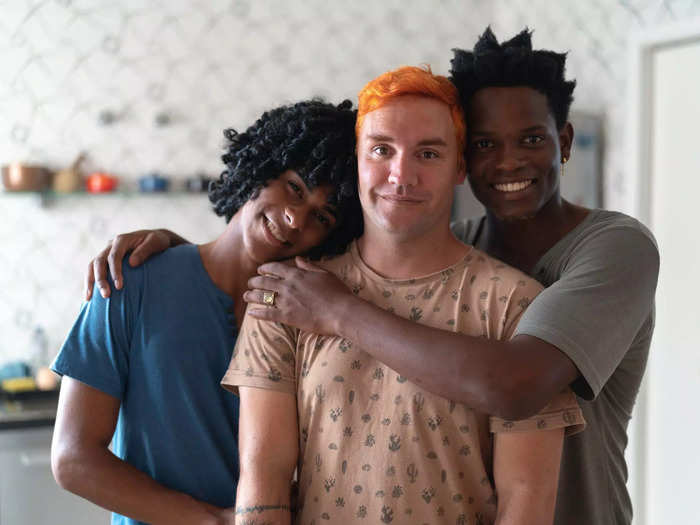More and more Americans are considering non-monogamous relationships like open relationships or polyamory.FG Trade/Getty Images
- Over the last decade, an increasing number of people are showing an interest in non-monogamous relationships.
- There's no single correct way to practice non-monogamy, so terms like "polyamory" and "open relationship" can help someone pinpoint their desires.
Non-monogamy, where someone has simultaneous relationships with more than one person, is becoming an increasingly popular relationship style.
One in nine Americans (10.7%) have reported being in a non-monogamous relationship, while one in six Americans (16.8%) have said they'd like to try one out, according to the results of a 2021 study from researchers at the Kinsey Institute.
On social platforms like Instagram and TikTok, people in non-monogamous relationships explain what it's like, sometimes using terms, like "metamour" and "compersion," that may be unfamiliar to people who have only been in monogamous relationships.
Since there's no one way to have a non-monogamous relationship, many terms describe certain setups people have with their multiple partners, like "polyamory" and "open relationship."
Here, Insider explains terms you may come across when discussing non-monogamous relationships.
Consensual non-monogamy
At some point in their lives, 5% of Americans, are involved in a non-monogamous relationship. Dougal Waters/Getty Images
This is an umbrella term for all non-monogamous relationship dynamics where all partners know the setup and agree to it.
This could include any dynamic where partners have multiple consensual romantic, sexual, or intimate connections, including polyamory, an open relationship, or swinging (more on those in a bit). Since consensual non-monogamy defies the idea that one type of relationship works best for everyone, these terms may hold different meaning to different people.
Cheating, while a form of non-monogamy, is not consensual because it involves one partner, the one who is being cheated on, being unable to agree to the dynamic.
Ethical non-monogamy
Some people who are non-monogamous think the term should be retired. Shutterstock/88studio
This term is sometimes used interchangeably with "consensual non-monogamy."
But people who practice non-monogamy often disapprove of using this term because it suggests that non-monogamy is inherently unethical, and unless you practice it a specific way, you are not doing so correctly.
In reality, there is no "correct" way to engage in a consensual non-monogamous relationship, so long as partners agree to the setup, therapist Rachel Wright, who is in a non-monogamous relationship, told Insider.
Polyamory
There are multiple styles of polyamory. NoSystem images/Getty Images
Generally speaking, people in polyamorous relationships have multiple romantic partners and their connection goes beyond the physical. Every polyamorous relationship looks different, depending on what each of the partners involved agree to in their dynamic.
Open relationship
Both partners are free to date others in an open relationship. Viktorcvetkovic/Getty Images
In an open relationship, one type of non-monogamy, partners agree that they can each seek other relationships outside of their own.
People in open relationship tend to explore sex with others outside of their relationship while reserving emotional and romantic connections for their primary partner. However, that isn't always the case.
"Open relationships are more likely to have a 'don't ask, don't tell' rule," than polyamorous relationships, once baseline rules between partners are established, Terri Conley, an associate professor of psychology at the University of Michigan who focuses on sexual behavior and socialization, told Refinery29.
In some cases, a monogamous couple may choose to "open" their relationship after being sexually exclusive for some time so they are free to explore sex with others.
Swinging
"2 HotWives" podcast hosts Kat and Ams have yet to reveal their real names or faces. Despite loving their community of swingers, they say they fear judgment from the public. Courtesy of 2 HotWives
Swinging, like an open relationship, involves partners having physical intimacy with someone who isn't their spouse or primary partner, but often includes the primary partner too.
An example of swinging includes having a threesome, where you and your primary partner agree to have a sexual experience with a third person who isn't romantically involved.
Another dynamic involves two couples swapping partners for a sexual experience, like "2 HotWives" podcast hosts and best friends Kat and Ams discuss on their show, Insider previously reported.
Metamour
You may want to meet your partner's metamour, but it's not a requirement. FG Trade/Getty Images
A partner's partners are referred to as "metamours."
For example, if you're in an open relationship and your primary partner has a boyfriend, that boyfriend would be a "metamour" to you.
Polycule
Polycules can look different depending on who is in them. Flashpop/Getty Images
A polycule is someone's extended network of partners and metamours. In any given polycule, people might have sexual, emotional, or romantic connections with multiple members.
Primary partner
In open relationships and swinging dynamics, people typically have primary partners. Marco_Piunti / Getty
This term refers to two partners who iew their relationship with each other as their main focus, but agree to having other relationships, like through an open relationship or swinging.
Compersion
When you're happy for your partner's happiness that has nothing to do with you, that's compersion. Alan Chin for Insider
Compersion refers to a feeling when you're content about your partner's happiness in their other relationships, even if it has nothing to do with you.
Often, people in relationships, non-monogamy included, must cope with feelings of jealousy. When they learn to work through jealousy, the result can be compersion, Amy Moors, a Chapman University psychology professor and relationships researcher, told Insider.









